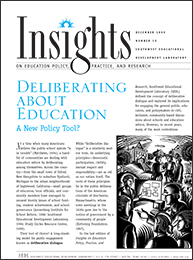How Do State Policymakers interact with the Public?
. . . legislators report input from members of their immediate constituency as the most important source of information they use in policy decisionmaking.
According to a mail survey of state legislators in Arkansas and Oklahoma (Pan, 1999), legislators report input from members of their immediate constituency as the most important source of information they use in policy decision making (see table above). The 30 legislators responding to the survey indicated they use multiple avenues for staying in touch with the views and needs of constituents; an average of seven different sources of information from the public were reported by each respondent. However, even with numerous information sources at hand for tapping the public mind, more than half of the policymakers (58 percent) expressed the need for better ways to gain insights into the views of their constituents. This is despite the fact that the majority of respondents indicated the information they obtain from these sources represents diverse viewpoints (93%), is sufficient in quantity (89%), and is reliable and up-to-date (74%).
It is clear that legislators value public input and appreciate existing opportunities to communicate with their constituents, but there appears to be a mismatch between what they gain—satisfactory as it seems—and what they want from their communications with the public. A brief look at a few of these conventional public opinion gauges provides some insight into this apparent paradox.
Direct constituent contact via telephone calls, letters, and email represents one of the most common avenues for information about public views reported by these 30 legislators. However, the perspectives they offer are likely to be skewed to reflect a rather narrow segment of the policymaker’s total constituency—those who believe it is possible, important, and productive to communicate with their elected officials.
A similar effect holds true for the use of human networks; state policymakers often solicit trusted individuals’ reactions to an issue as they seek a sense of the broader public opinion. Although this reaching out for public opinion allows the policymaker to tap additional constituent experiences and ideas, it remains likely that the views of people in their immediate personal and professional circles will not reflect those of the population as a whole.
A third source of direct, individual input from the public is the hearing, town meeting, or other public forum. This avenue—although generally representing an open invitation to larger numbers of people—tends to invite position taking and debate. Further, these traditional public forums can compound the problem of bias if they degenerate into “media soapbox” opportunities for organized interest groups that regularly attend public meetings (National Conference of State Legislatures, 1997).
Finally, many legislators use public opinion polls. Well-designed polls and surveys can ensure that a representative section of the public is queried, and the results may provide an excellent snapshot of public opinion at a given point in time. However, these tools do little to capture the extent of respondents’ knowledge or investment in an issue. Nor can they assist a policymaker by revealing any willingness on the part of the public to accept the tradeoffs of various policy alternatives (Yankelovich, 1992).
Next Page: What is Unique about Deliberative Dialogue?

